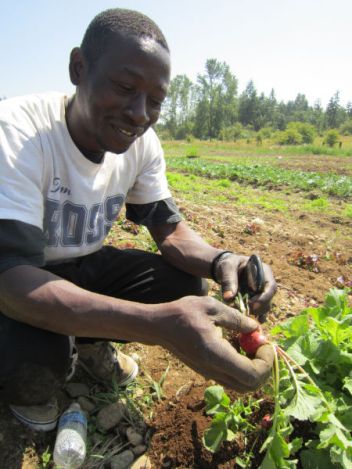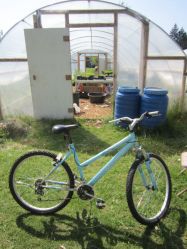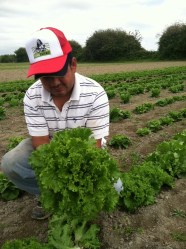
Jennifer LangstonAli Isha, a Somalian refugee farmer, tried his luck growing vegetables this summer as part of a farm incubator program.
Ali Isha used to work on a large family farm in Somalia, growing maize, rice, sweet potatoes, beans, bananas, onions, tobacco, and livestock. Until the soldiers took the cows and the corn and threatened to kill his family. Civil war made it impossible to stay, so they walked for days to refugee camps at the Kenyan border.
Isha came to the U.S. nearly a decade ago, one of thousands of refugees unable to return to their home countries because of war or persecution. After a series of jobs fixing tractors, waxing hospital floors, cleaning airports, and processing meat, he wanted to grow and sell food again. Which is how he arrived this summer at a rocky farm southeast of Seattle that serves as an incubator for immigrants and other aspiring farmers.
Today, agricultural experts are looking to minority and immigrant groups — from Latino farmworkers [PDF] to refugees starting over in this country — to fill a looming void as aging farmers who now grow our food begin to retire in massive numbers [PDF]. They’re frequently mentioned in conversations about the new “next generation” of farmers.
It’s true that minority-operated farms were among the fastest growing from 2002 to 2007, the last year with updated data from the national Census of Agriculture [PDF]. Despite likely undercounting, it still found the number of Latino farm operators grew by 14 percent, Asian farm operators by 40 percent, and African-American farm operators by 9 percent (compared to 6 percent for white farm operators).
But that growth belies this fact: The chances are overwhelming that a person running a farm in this country — at least the ones paying the bills and running the front office — will be white. Nearly 96 percent of farm operators were in 2007, according to the survey. It’s certainly not that white people are the only ones who know how to produce food. Our agricultural economy runs on immigrant and minority labor, and it only seems fair that the people who already work hard to grow our food should have the opportunity to start new farms alongside young, unencumbered hipsters and white-collar job refugees with stock options. But immigrant and minority farmers have historically had even bigger hurdles to overcome.
Take Isha. He planted beets, carrots, collard greens, chard, and many other vegetables. The problem wasn’t that he didn’t have enough produce to sell, but that he had too much. Head-high mustard greens had gone to seed without finding a buyer. Orders hadn’t materialized in the quantities he’d expected, and without a car or nearby bus service, approaching customers was difficult. By mid-summer he was bringing in more money from food stamps than farm income, which was less than $100 a week.
“It broke my heart when my stuff [was] not getting to market, and I’m not really getting what I need. It broke my heart to do farming so maybe next year, I’ll do something different,” Isha said.
Working in fields or orchards may teach one about growing crops but precious little about running a profitable business. Farms require start-up capital, and people of color have often not had equal access to credit that can finance a land purchase or can grow a business. U.S. Department of Agriculture programs designed to help farmers have not historically been geared towards reaching minorities, and in some cases have demonstrably discriminated against them. And becoming an entrepreneur is even tougher for someone who isn’t comfortable speaking English, has never owned a computer, or who grew up in a cash-based society and tries to save money by sticking checks in a drawer.

Jennifer LangstonThe shared greenhouse at Farm Works, an incubator program.
To address some of those inequities and build more production capacity, a growing number of incubators and community farms aimed at supporting minority farmers have sprung up around the country. To varying degrees, they offer access to affordable land, financing, shared infrastructure like irrigation pipe and tractors, and even customers.
Pioneering organizations have proved the model can work, from the Agriculture and Land-Based Training Association (ALBA) that helps California farmworkers and limited-resource farmers go into business for themselves, to the Indochinese Farm Project [PDF] that helped Hmong refugees find a niche selling flowers at Seattle’s Pike Place Market in the 1980s. That nonprofit incubator, which operated for nearly a decade, helped newly arrived families learn basic farm skills like operating mechanized farm equipment and making change with American money.
But even with that support, aspiring farmers can still run into tough market realities.
Eddie Hill, who worked with Isha and other Somali Bantu farmers this summer at Seattle Tilth’s Farm Works incubator, said farm managers approached many restaurants, institutions, and groceries about buying their sustainably farmed produce. Though many were intrigued, relatively few businesses placed orders. The reasons ranged from established relationships to the tough economy to the fact that they needed a different kind of lettuce than what the farmers had planted.
“Using food to address social justice and economic justice issues without discussing the painful realities of agriculture to me is a disservice,” Hill said. “The market doesn’t care if you’re an African immigrant or if you have issues or if you’re broke and poor. The customer wants what it wants and wants it on time.”
As people work to blunt those painful realities, some wisdom has emerged: It’s possible for immigrant and limited-resource farmers to find a niche in local farming ecosystems, but it won’t happen without considerable support. And business and marketing skills are key.
Take Salvador and Misael Morales, who have worked in farm fields since they were boys, picking everything from cauliflower to cucumbers to berries. A decade ago, they leased land from a property owner in Bow, Wash., and tried to start their own farm. But come harvest time, they realized they were missing an essential ingredient: paying customers.

Jennifer LangstonSalvador Molares.
“I thought we would sell in big markets, but I didn’t really have any idea how to do it,” Salvador Morales remembers.
Several years later, they tried again, this time with the support and training offered by the Viva Farms incubator, a joint venture in Skagit County, Wash., between the nonprofit GrowFood and Washington State University.
Like most of the growers who now rent land at Viva Farms, the Morales brothers first took intensive farming and business classes, which are offered simultaneously in Spanish and English and teach would-be farm entrepreneurs how to manage everything from unwanted pests to accounting spreadsheets.
Graduates with solid business plans — which include Latino agricultural workers, carpenters put out of work by the housing bust, and unfulfilled professionals looking to change gears — can rent plots of irrigated land next to the local airport. They share expensive infrastructure, such as a greenhouse and cold storage, which would normally be out of reach for farmers just starting out.
A serious investment in marketing and distribution has driven the incubator’s early success. In its first year, managers noticed that cultural barriers made it difficult for their Latino growers to approach and sell directly to customers. They gravitated towards wholesalers and processors that regularly work with Latinos but buy cheaply and in bulk. So Viva Farms developed a distribution arm that buys produce directly from its growers and supplies a regional CSA that delivers weekly food boxes and a busy roadside produce stand.
Morales and his brother now sell to those Viva channels, which give them a guaranteed income stream while they develop their own relationships with restaurants and customers. It allows them to see what sells, learn market realities, and make mistakes without having their entire life savings on the line.
Morales says while his parents taught him a lot about growing food, they weren’t able how to teach him about business. He’s learned how to negotiate and get better prices, and, for now, the ends are meeting.
“I think this is an opportunity for us to be a business owner without that much education,” Morales said. “The lettuce has all the education. I only take care of them.”
This article is based on a longer series called “Betting the Farm,” which appeared on the Sightline Institute website in fall of 2012.




